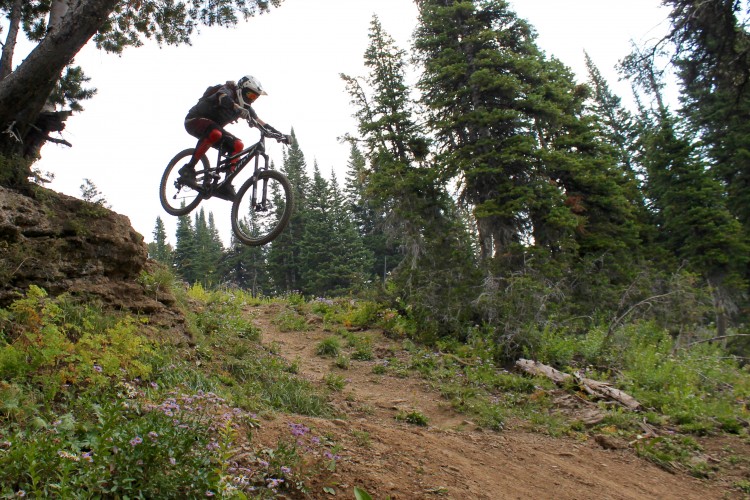
We all knew that eMTB engineers would eventually find the golden ticket to make their battery-powered pedalers feel more like muscle-powered bikes, which is something a lot of eMTB buyers have been asking for. Folks want a little help on the climbs from a bike that otherwise rides like their much lighter machines. Many of the current electric mountain bikes on the market feel so glued to the dirt that their pilots need a dedicated gym habit in order to ride them playfully. This was the primary element Santa Cruz set out to address with their 2020 Heckler CC.
The Heckler is on the lighter side for an electric bike, tipping the balance between 46 and 48lbs (21-21.5kg) depending on the build. With about 50% more heft than a similarly specced non-electric mountain bike, Santa Cruz was not about to find playfulness in a weight loss program alone. Instead, they looked to the suspension to add a little loft and liveliness.

Plugins, power buttons, and bolts galore. 
All the water bottle space.
This 27.5-inch-wheeled bike’s 250-watt Shimano Steps E-8000 motor is fed by a stealthy 504wh battery that sits as low in the frame as possible. With the motor riding just beneath the low slung VPP suspension platform, there is a mountain of tech around the Heckler bottom bracket.
I recently rode a Heckler CC during the Italian Santa Cruz press camp in Verona, somehow ending up aboard the second tier build with a SRAM XO1 derailleur and shifter, Code RSC brakes, 27.5-inch Santa Cruz carbon fiber rims and house-brand carbon handlebar, and a 160mm Fox Performance fork, all backed by a RockShox Super Deluxe Select Ultimate damper to manage the frame’s 150mm of rear travel. This build leaves little to be desired, and at 46.5lbs it’s just 0.21lbs. heavier than the top build. With retail prices set at $10,599 and $13,099 between the top two models respectively, that extra skosh of weight seems acceptable.

Geometry for the Heckler is based on the brand’s very popular Bronson frame, and the medium I rode has equal-length 445mm reach and chainstays for a total 1211mm wheelbase. The bike’s headtube leans into an industry-standard 65.5° and the 76.1° seat tube angle — which slackens a touch on larger frames — gives riders a good climbing position. Building bikes for small-to-tall mountain bikers has always been a priority for Santa Cruz, and apart from the reach and standover height, the stack is a key element of that equation. Tall riders need a high stack measurement to keep the front end balanced with their towering saddle height, and the size XXL Heckler delivers with a 655mm stretch between the BB and upper headset cup. The medium bike I rode has a 606mm stack height, which was easily adjustable with a handful of headset spacers.

Battery up and shreddy down
The two days I spent pedaling the Heckler made up my second experience with an eMTB and this bike proved a massive improvement over that first experience. I will likely point out things below that would be obvious to any avid eMTB shredder, but they were new to me.
I rode with the E-8000 motor in trail and boost modes throughout most of the first ride, chasing a local guide up steep rocky climbs for about three hours. By the time we stopped to refuel ourselves and our batteries, mine was almost entirely dead. On the second spin, I left the motor in eco mode and returned with about 70% battery life remaining. Depending on rider weight and terrain, you could likely ride for 5-6 hours on one battery if you keep your cadence up and the power assist low.

On climbs that I could pedal on a muscle-powered bike, the eco mode offers all the assistance I could ever want. After an hour or so of riding in eco I might have forgotten I was on an e-bike, were it not for the low song of a bionic-wasp humming between my feet. In the lowest motor mode, I was still doing a fair bit of work to pedal the bike, and since the motor pushes harder when you spin faster I was incented to maintain a high cadence so that it could really kick in and carry its own heft.
Trail and boost modes both proved fun on super steep climbs that I would likely be walking if I weren’t on an eMTB, though I found that boost kicked in too much power on steep technical trails, making it difficult to direct the front wheel between rocks and maintain traction out back. Likely, managing that extra power is an eMTB-specific skill that folks learn over time.
The Heckler’s VPP suspension shines all day on the descents, but it also works well with the geometry and motor torque on the way up. With a proper setup, the bike has very little pedal bob, and the suspension appears to be fully functional under hard sprint and braking forces. That’s an impressive achievement for any rear suspension design, and it’s particularly important with the added moving mass of an eMTB. The VPP design, aided by a massive Minion DHF tread, allowed the bike to grip and ascend nearly anything I pointed it at.
Pointed downhill, the Heckler’s 160mm fork and 150mm of rear axle travel let it plow with poised confidence through rough and rowdy singletrack. We didn’t ride the most technical trails during the two-day test, but when we did hit a rough section the bike’s weight and kinematics made it feel like a carpet ride. The Heckler has a notably smooth descending disposition, sending minimal trail feedback to the rider. It is more maneuverable in tight turns, and easier to jump than other heavy bikes I have ridden, but the weight of the motor and battery are still quite noticeable on descents. It’s far more stable than playful overall, even if it is “playful for an eMTB.”
One additional place where the Heckler’s well-slung weight and proficient suspension design genuinely shine is on banked turns. The bike’s low center of gravity gives it a glued feeling on berms that allows you to release the brakes and really rail on through as fast as you like. You can certainly shralp the same berms on a muscle-powered bike, but the Heckler feels like it’s specifically designed for the task.

Summing it up
So, does the Heckler ride just like a good ol’ muscle-powered bike? It doesn’t, and no one truly expected it to ride like one. What it does do is move the proverbial needle toward the sensations we all crave while mountain biking. It’s far more fun to ride than I would expect from such a heavy sled. The suspension platform gives it a composed and stable descending character, and the build kit is well suited to its sendy intentions. With a price tag starting where most muscle-powered bikes top out, it’s certainly marketed to a particular segment of riders, and those eMTB lovers will be stoked with how the Heckler performs.

For pricing and build options, check Backcountry.com and Competitive Cyclist.
























0 Comments